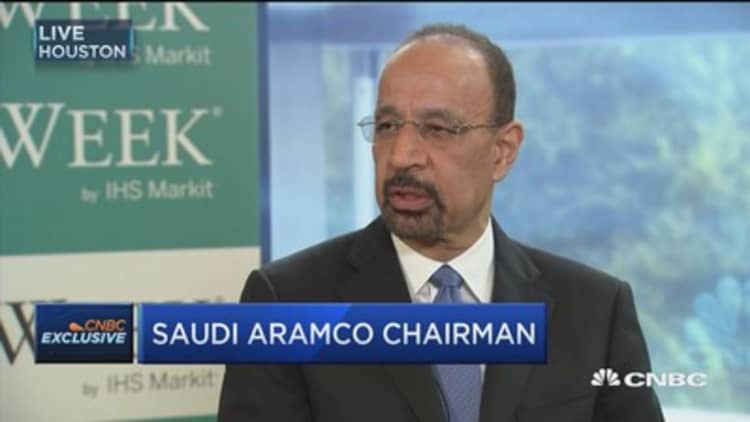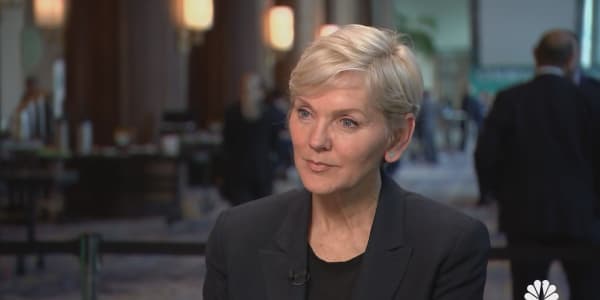
Oil is on track to break through the key psychological level of $50 a barrel after a ninth straight rise in U.S. crude stockpiles came at exactly the wrong moment, analysts said Wednesday.
The amount of crude oil in U.S. storage rose to another record high on Wednesday, jumping 8.2 million barrels from the previous week, the Energy Information Administration reported. The increase was more than four times what analysts expected.
Weekly figures also showed U.S. oil production continuing to tick up toward 9.1 million barrels a day, the highest level in more than a year. That provided further evidence that rising American output is confounding efforts by the Organization of the Petroleum Exporting Countries, Russia and 10 other exporters to reduce global oil inventories by curbing their own output.
It's really been like a kettle boiling for the last few weeks in terms of having traded in a very tight range. There's been this pressure building from a technical perspective.Matt Smithdirector of commodity research, ClipperData
The data sent U.S. benchmark West Texas Intermediate crude prices plunging more than 5 percent to a nearly three-month low.
The plunge through a number of lows on Wednesday puts oil on a path to test the December low of $49.95 a barrel, said John Kilduff, founding partner at energy hedge fund Again Capital.
"From there you could accelerate," he told CNBC, adding that $50 "was the fail-safe." Kilduff's downside target, once oil breaks below $50 a barrel, is $42.
For the last three months, oil has traded in a range between $49.61 and $55.24.
According to Kilduff, all the elements are in place for oil to break below its three-month range: lack of cohesion among OPEC members, bearish statements from oil ministers at CERAWeek conference by IHS Markit and subdued refinery activity as operators perform seasonal maintenance in the United States.
Bearish OPEC comments at CERAWeek
On Tuesday, Saudi Oil Minister Khalid al-Falih warned at CERAWeek that the kingdom would only support OPEC's intervention in markets for a "restricted period of time" and would not "underwrite the investments of others at our own expense and long-term interests."
Later that evening, oil ministers convened a last-minute press briefing, where they reaffirmed their commitment to the production cut deal.
"The Saudis almost explicitly warned that if we don't get cooperation or we see cheating we're not going to be someone's patsy forever," said Tom Kloza, global head of energy analysis at Oil Price Information Service.
Saudi Arabia has so far provided the lion's share of output cuts as OPEC and other producers seek to remove 1.8 million barrels from the market in the first six months of 2016. Iraq, OPEC's second largest producer, produced above its quota in January.

Also at CERAWeek on Tuesday, Iraqi Minister of Oil Jabbar Ali Al-Luiebi said Baghdad could increase its output capacity to 5 million barrels a day by the second half of 2017, raising concerns about its commitments to production cuts.
Andy Lipow, president of Lipow Oil Associates, said $50 can now be considered a target. If oil prices break that level, market watchers can expect more talk from oil ministers about extending the OPEC agreement another six months when producers meet in May, he added.
"I think that OPEC is hoping they can wait it out so they don't have to make a decision in May to continue with production cuts, but they may be forced into that decision given the high inventories here in the U.S.," he said.
Those inventory builds are likely to continue through the refinery maintenance season, according to Lipow.
Kettle finally boils over
Further fueling the fall to $50 a barrel is the record number of bets traders have recently made on crude rising further, said Matt Smith, director of commodity research at shipment tracking firm ClipperData. As oil prices fall to the bottom of their range, more traders will look to unwind those positions, he explained.
"It's really been like a kettle boiling for the last few weeks in terms of having traded in a very tight range. There's been this pressure building form a technical perspective," he said. "As that happens, as that pressure builds, we tend to pop violently."

Kloza also sees the anniversary of crude oil storage leases playing into the problem.
Many traders took out one-year leases around this time in 2016, when crude prices were near the lows of the downturn, he explained. Now that the oil price curve is flattening — meaning prices for future crude deliveries are declining relative to current costs — traders have little incentive to sign another one-year lease. Instead they're selling that oil into an oversupplied market.
While the next 30 days provide an environment ripe for a drop below $50 a barrel, Kloza said, he doesn't see an "apocalyptic move lower."
"We may break below that range for about 90 days, but in the end I think we'll be above it come driving season," he said. "From now through let's say May, it may be stormy times," he said.





